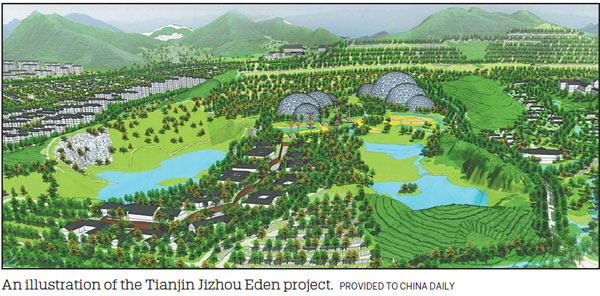Mine-pit makeovers offer a glimpse of Eden

A played-out strip mine - an ugly environmental mess - was magically transformed in the United Kingdom by one man's vision, starting in the mid-1990s.
Today, words hardly do justice to the spectacular horticultural, educational and leisure destination known appropriately as the Eden Project, the brainchild of British environmentalist Tim Smit, which now stands near Cornwall in southwestern England. The project is an educational charity on an epic scale, connecting people to the living planet.
Massive climate-controlled geodesic domes, nestled in a crater, house the world's largest manmade rainforest. The grounds outside are lush and green, rivaling the moon Pandora of Avatar movie fame.
Now the Eden magic is coming to northern Tianjin, where authorities plan to transform a defunct coal mine from pit to paradise.
Affiliated with the mega project in England and guided by its experts, the Eden effort in Tianjin's Jizhou district is a pace-setting approach for dealing with thousands of mines in China that have been decommissioned because of concerns over environmental pollution - around 300 of them in Jizhou alone. Completion of the Tianjin project is scheduled for 2021.
What to do with such wastelands has been a puzzle. But now the authorities are catching Eden's vision of how to turn the sites into tourist attractions.
The Eden concept is even spreading beyond mine reclamation. In coastal Qingdao, Shandong province, and in inland Yan'an, Shaanxi province, for example, other kinds of land have been appropriated for similar facilities. In New Zealand and the United States, a similar approach has been adopted.
With an investment of 9 billion yuan ($1.28 billion), Jizhou's Eden project will cover 1.14 square kilometers, said Li Qun, an executive of Jizhou Urban Construction Investment Co, which is managing the project.
Li Jian, vice-director of the district, has "high hopes the project will lure 2 million tourists, create 10,000 jobs and generate tax revenues of up to 1 billion yuan within four years".
The Eden Project's UK version currently hosts more than a million visitors and has brought in about $2 billion.
Eden represents one of the more attractive solutions to the problem of defunct mines. Local governments are hurting from the loss of revenues after a massive wave of mine closings that began in 2017.
China Mineral Resources News said that by 2020, China will have closed up to 12,000 coal mines, a figure that's expected to balloon to 15,000 by 2030, because of environmental concerns.
Li Jian, Jizhou's vice-director, said the district has closed up to 12.46 square kilometers of mines, and an additional 50 sq km have been closed in surrounding areas.
"It is critical for us to deal with the deteriorating ecology and environment," Li said.
Since 2013, the district has been bulldozing the land flat at five major sites, but other projects require a more hefty investment.
Xiao Fei, senior engineer at the Tianjin North China Geological Exploration Bureau, said many of the closed mines in Jizhou and others around the country are located in ecological conservation zones, where it's much more difficult, and expensive, to undertake long-term conservation beyond basic surface rehabilitation.
Some mine areas initially turned green but then reverted because of a lack of sustained care. For example, all of the trees that had been planted at a closed 1.33-sq-km copper mine in the Tongguan Mountain area of Tongling, Anhui province, died just a year later.
If a mine is not located in a conservation zone, other concepts are possible. For instance, at a recent national mine summit in Tianjin, it was suggested that companies turn some rehabilitated mine sites into testing centers for driverless vehicles, a sector that's booming in China.
Even more innovative, a five-year plan for 2016-20 calls for building "smart mines", a concept that would make them more "digitalized, information-driven and intelligent".
In addition, nearly 700 Chinese companies began a "green mine" campaign in 2017 that combines production with environmentalism.
A prime example is Jin Hui Mining Co's operation in Longnan, Gansu province, which produces 1.5 million metric tons of lead and zinc annually using heavy equipment.
But if you visit the quiet, forestlike environment at the surface, you might not know the mine exists. A natural area beckons visitors, even as the digging machines work 800 meters below the surface, well out of earshot.
"We are proud of the fact that we can hear birds singing outside but cannot hear any noise produced by the machinery underground," said Zhang Shixin, a board member of the mining company and Party chief of Gansu Yatter Investment Group.
The site has been designated a national-level 4A scenic area, with 800,000 square meters of trees.
Jin Hui Mining Co was honored as the nation's first "green factory" by the Ministry of Industry and Information Technology and has become a role model for the province.
Randy Wright contributed to this story.
Contact writers at yangcheng@chinadaily.com.cn

Copyright © Tianjin Municipal Government.
All rights reserved. Presented by China Daily.
京ICP备13028878号-35



